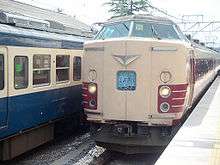Shiosai
The Shiosai (しおさい) is a limited express train service in Japan operated by East Japan Railway Company (JR East). It runs from Tokyo and Shinjuku to Chōshi on the Bōsō Peninsula in Chiba Prefecture.
A 255 series EMU on a Shiosai service at Chōshi in August 2010 | |
| Overview | |
|---|---|
| Service type | Limited express |
| Locale | Sōbu Main Line |
| First service | 10 March 1975 |
| Current operator(s) | JR East |
| Former operator(s) | JNR |
| Route | |
| Start | Tokyo |
| End | Chōshi |
| Distance travelled | 120.5 km (74.9 mi) |
| On-board services | |
| Catering facilities | Trolley service |
| Technical | |
| Rolling stock | 255 series, E257-500 series EMUs |
| Track gauge | 1,067 mm (3 ft 6 in) |
| Electrification | 1,500 V DC overhead |
| Operating speed | 130 km/h (80 mph) |
Station stops
Shiosai services operate over the Sōbu Main Line, stopping at the stations listed below. No services operate as "Local" all-stations services in any section; this characteristic is different from that of Wakashio ltd.exp..[1][2][3]
Tokyo - Kinshichō - Chiba - Sakura - Yachimata - Narutō - Yokoshiba - Yōkaichiba - Asahi - Iioka - Chōshi
- No.1 & 12 trains also stop at Funabashi station.
- No.2, 4 & 13 trains also stop at Yotsukaidō station.
Rolling stock
- 255 series 9-car EMUs (since 10 December 2005)
- E257-500 series 5/10-car EMUs
Shiosai services are operated using Makuhari-based 9-car 255 series EMU and 10-car E257-500 series EMU formations. The E257-500 series formations have no Green (first class) cars.[4][2]
Past rolling stock
- 183 series EMUs (10 March 1975 – 2005)
Formations
Trains are formed as shown below, with car 1 at the Tokyo end.[1][5]
9-car 255 series
| Car No. | 1 | 2 | 3 | 4 | 5 | 6 | 7 | 8 | 9 |
|---|---|---|---|---|---|---|---|---|---|
| Numbering | KuHa 254 | MoHa 254 | MoHa 255 | SaRo 255 | SaHa 254 | SaHa 255 | MoHa 254 | MoHa 255 | KuHa 255 |
| Accommodation | Non-reserved | Non-reserved | Non-reserved | Green | Reserved | Non-reserved | Non-reserved | Non-reserved | Non-reserved |
As of 2019, cars no. 2 and 3 are reserved on some services.[2]
5+5-car E257 series
| Car No. | 1 | 2 | 3 | 4 | 5 | 6 | 7 | 8 | 9 | 10 | |
|---|---|---|---|---|---|---|---|---|---|---|---|
| Numbering | KuHa E256-500 | MoHa E257-1500 | MoHa E256-500 | MoHa E257-500 | KuHa E257-500 | KuHa E256-500 | MoHa E257-1500 | MoHa E256-500 | MoHa E257-500 | KuHa E257-500 | |
| Accommodation | Non-reserved | Non-reserved | Non-reserved | Non-reserved | Non-reserved | Non-reserved | Reserved | Non-reserved | Non-reserved | Non-reserved |
Past formations

Trains were originally formed of 9-car 183 series EMUs, including one Green car, or 6-car sets with no Green car,[6] but from December 1994, services were formed of 8-car 183 series sets with the Green car removed, as shown below.[7][8]
8-car 183 series
| Car No. | 1 | 2 | 3 | 4 | 5 | 6 | 7 | 8 |
|---|---|---|---|---|---|---|---|---|
| Accommodation | Reserved | Reserved | Non-reserved | Non-reserved | Non-reserved | Non-reserved | Non-reserved | Non-reserved |
History

The Shiosai service was introduced from 10 March 1975 following the completion of electrification of the Sōbu Main Line in October 1974, using 9-car 183 series EMUs, replacing five of the seven daily diesel-powered Inubō (犬吠) express services that operated between Shinjuku/Ryōgoku and Chōshi.[8]
From the start of the November 1982 timetable revision, further 183 series EMUs were drafted in, displaced from Toki limited express services following the opening of the Joetsu Shinkansen,[9] and the remaining Inubō express services were discontinued and absorbed into the Shiosai services, giving seven return workings daily.[8]
From the start of the revised timetable on 10 December 2005, 255 series 9-car EMUs were introduced on Shiosai services.[5] From the same date, services were made entirely no-smoking.[5]
From the start of the 14 March 2015 timetable revision, all Shiosai services started and terminated at Tokyo Station, with no services operating from Shinjuku.[10]
References
- JR Timetable. Japan: Kotsu Shimbunsha. April 2016. p. 95–95, 984.
- 千葉を走る列車>しおさい:EAST JAPAN RAILWAY COMPANY Chiba branch Japan
- 千葉を走る列車>わかしお:EAST JAPAN RAILWAY COMPANY Chiba branch Japan
- JR新幹線&特急列車ファイル [JR Shinkansen & Limited Express Train File]. Japan: Kotsu Shimbun. 2008. p. 646. ISBN 978-4-330-00608-6.
- JR電車編成表 2012冬 [JR EMU Formations - Winter 2012]. Japan: Kotsu Shimbunsha. October 2011. pp. 50–51. ISBN 978-4-330-25611-5.
- 国鉄電車編成表1985年版 [JNR EMU Formations - 1985]. Japan: Kotsu Shimbunsha. October 2010. p. 30. ISBN 978-4-330-17610-9.
- こだわりの新幹線&特急列車ガイド [In-depth Shinkansen & Limited Express Guide]. Japan: Ikaros Publishing. August 2000. pp. 84–85. ISBN 4-87149-284-2.
- Teramoto, Mitsuteru (July 2001). 国鉄・JR列車名大辞典 [JNR & JR Train Name Encyclopedia]. Tokyo, Japan: Chuoshoin Publishing Co., Ltd. p. 266. ISBN 4-88732-093-0.
- JR特急列車年鑑2013 [Limited Express Annual 2013]. Tokyo, Japan: Ikaros Publications Ltd. 20 December 2012. p. 166. ISBN 978-4-86320-654-0.
- JR Timetable. Japan: Kotsu Shimbunsha. February 2015. EAN 4910053110259.
External links
| Wikimedia Commons has media related to Shiosai. |
- JR East 255 series Shiosai/Wakashio/Sazanami (in Japanese)
- JR East E257 series Wakashio/Sazanami/Shiosai/Ayame (in Japanese)
.svg.png)